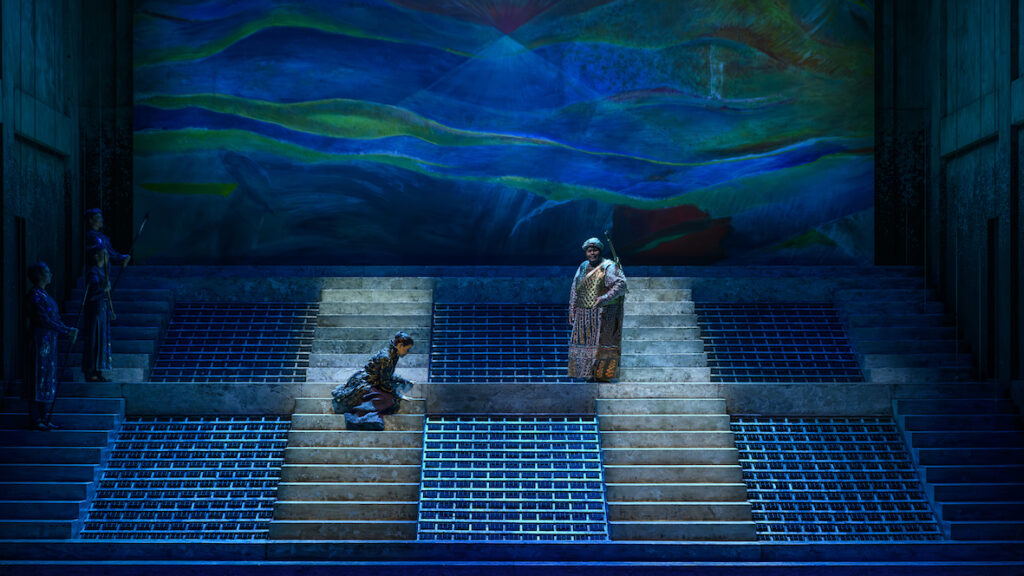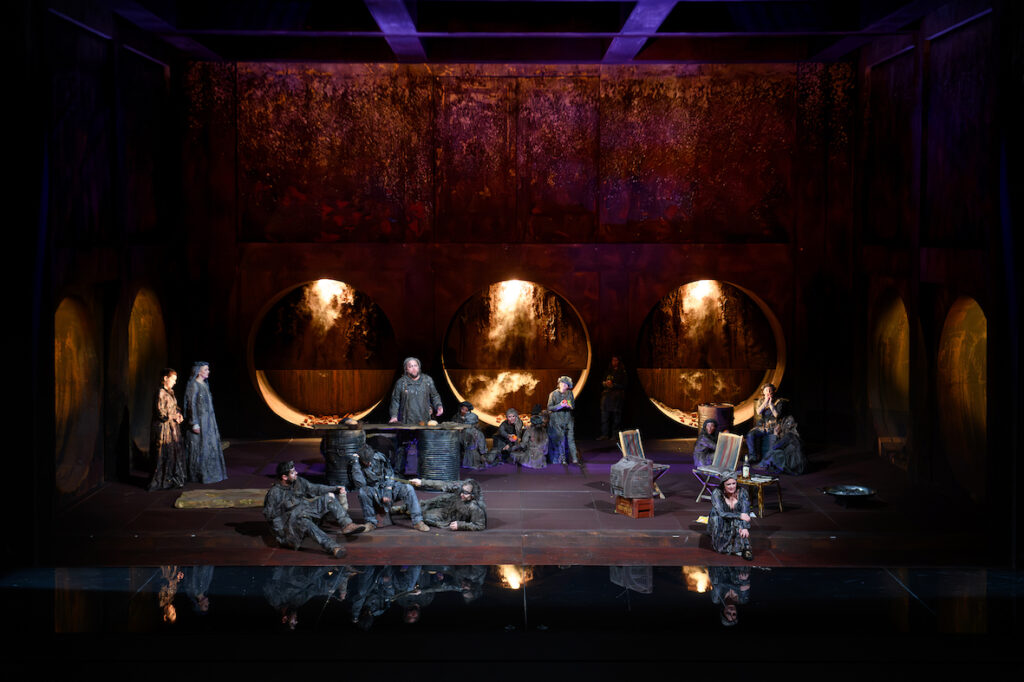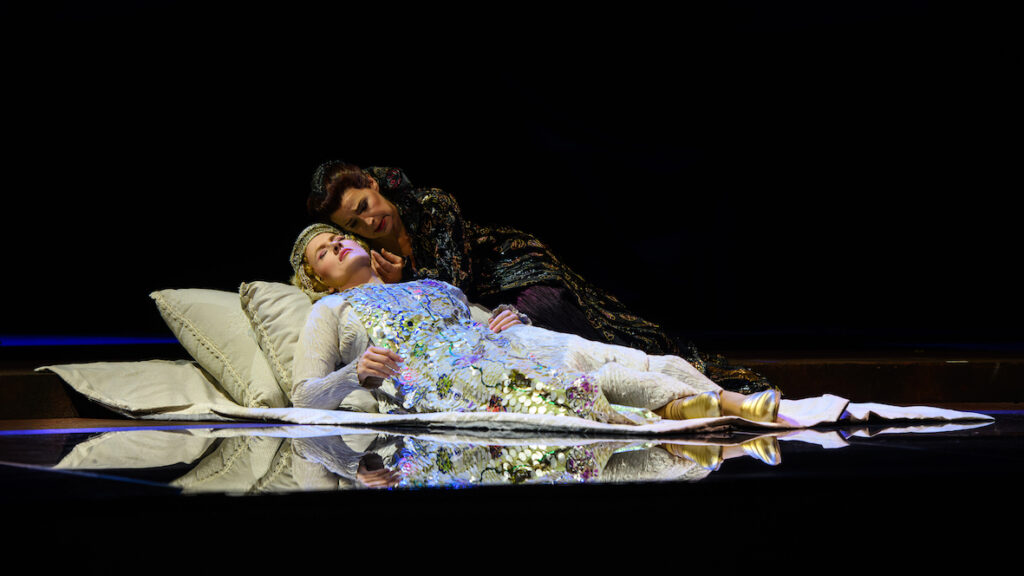The fifth opera in the Richard Strauss canon — the one that is truly gigantic — staged just now at Toulouse’s acoustically famed 1150 seat Theatre du Capitole in the splendid 2006 production by the late Nicholas Joel and his designer, the late Ezio Frigerio.
Very much alive in Toulouse was the electric presence of German conductor Frank Beermann and the Orchestre national du Capitole, replete with all players needed to realize Strauss’ massive score, effecting the astonishing fortes of the earthquake and, in the end, the magnificent, sonic triumph of humanity. The flutes and oboes instilled the disturbing dissonances of the falcon’s wailing call, a bassoon lamented the intimacies of sorrow, and a cello quartet warmed the hut’s heart, all this against the Elektra-like maelstrom that tormented the souls of the opera’s protagonists.
It is indeed Strauss’ richest score, Hofmannsthal’s sprawling, symbolist libretto awarding the composer myriad opportunity to musically explore the lowly human condition as it extends into its most basic spiritual extensions. The story is essentially the same as The Magic Flute, with the inscrutable symbolist mysteries of Pelleas et Melisande thrown in. Wagnerian philosophical myth is never far away, and the scent of the nascent National Socialism is maybe just a bit perceptible.

The design metaphor was minimalist geometry — the lighted planes and grids of the suspended spirit world, the dark circles and holes of the human world. Myriad stairs connect these two worlds within a huge, complex stage apparatus that glided effortlessly and magically from one world to the other, exactly timed to the orchestral intrusions that bind the scenes. The stage apron itself was the visual key — its reflective surface a constant reminder that we were in a surreal, symbolic world.

Equally minimalist in its storytelling was the Nicholas Joel staging, realized by stage director Stephen Taylor. The nurse remained always the pivotal force, a very magical presence that clearly provoked all action, motivated by her distaste of the lower, human world. The dyer’s wife was forever petulant and flighty, the dyer himself was warm and accepting of anything, almost. The emperor was lost in the woods somewhere, searching for his falcon, not sure how he found himself in an opera. The empress, possessed by love, was the passive observer of her nurse’s machinations until she was made to feel the warmth of real, honest human emotion. She then banished her nurse and proclaimed — spoken, not sung — “ich bin nicht” in a shattering, very un-Straussian, highly theatrical orchestral silence.
Minimalist imagery defined the two worlds of the opera. The warmth of dyer’s world was present in the three fires that inhabited his hut, enabling his toil, indeed his life. The intimacy of opera’s extended monologues were directly expressed to us by the upper-world protagonists standing on the reflective stage apron. The magic of the fish children being fried, the earthquake and the fountain of life were assigned not to scenic effects but left to the magic of the Strauss score in abstract sonic metaphors.
The greatest glory of the production was, then, the Strauss score that illuminated Hofmannsthal’s strange, retro exploration of 18th and 19th century European social thinking. Conductor Beermann left no musical stone unturned. It was a brash, immediate rendering of the musical tenets of post Romanticism, with grandiose overtones of expressionism forcefully implied. The orchestra of the Théâtre du Capitole is a virtuoso ensemble that rose to magnificent volumes when not whispering under the quite beautiful moments of solo violin and solo cello.
Die Frau ohne Schatten is infamous for its requirement of five heroic singers. The Théâtre du Capitole assembled a cast of great interest. Of foremost effect was the Nurse, sung by French mezzo-soprano Sophie Koch (also Toulouse’s Isolde, Sieglinde and Kundry). With minimal body language she created an other-worldly presence that never faltered as she ruthlessly manipulated the Empress, the Dyer and the dyer’s wife. Mme. Koch was in fine voice, well able to ascend to the upper reaches of the role in beautiful tone, and finally to accept her banishment in heart-rending motions of defeat.
American baritone Brian Mulligan made a huge impression as Barak, the dyer. Mr. Mulligan possesses a voice of warmth and beauty that brought extraordinary prominence to this role, allowing his character to soar musically, investing this Strauss role with a seldom discovered lyricism. The Barak persona is complex, Mr. Mulligan embraced his character’s opposing forces — a supposed brutish personality that embodies enormous sympathy. See lead photo.
Barak’s wife was sung by German soprano Ricarda Merbeth. The Dyer’s Wife is known as a treacherous role, requiring considerable force and size to rise over the Straussian maelstrom that defines her tormented character. She is obviously highly neurotic, making her a heroine nearly equivalent to Elektra. Mme. Merbeth found a brutish petulance for the role that never faltered, vocally strident as needed, coyly contrite when she needed to be, with conflicting emotions always superimposed. Mme. Merbeth well met the role’s formidable challenges. See lead photo.

The Empress was sung by Norwegian soprano Elisabeth Teige, the Emperor was sung by American tenor Issachah Savage. Both artists are of golden colored, forcefully heroic voices that served to place their characters apart from, and above the characters of the lower world. The Empress managed her Act I coloratura with apparent ease, and had the stratospheric reserve needed to surmount her huge, Act III confrontation with her unseen (or heard) father. Mr. Savage had all needed forces to surmount the extreme tessitura of his magnificent Act II monologue.
Of particular note was the role of the king (Kiekobad) of the spirits’ messenger beautifully sung by French bass-baritone Thomas Dolié, as were Barak’s brash and lively brothers, sung by Aleksei Isaev, Dominic Barberi and Damien Bigourdan.
Nicholas Joel was the artistic director of the Théâtre du Capitole from 1991 through 2008. Aside from the administration of the theater he bequeathed Toulouse a sizable legacy of productions that continue to be staged (in recent years I have seen his Die Walküre and Tristan und Isolde). Among his contributions to the Théâtre du Capitole was his refitting of its stage housing in 2004, making it possible to mount productions as complex as this 2006 La Femme sans Ombre.
Ezio Frigerio designed the sets for Giorgio Strehler’s famed production of Le nozze di Figaro that held the stages of Versailles, the Garnier and finally the Bastille from 1973 until 2011. Frigerio’s wife, Franca Squarciapino designed the costumes for the Strehler Nozze, as well as all the later Frigerio productions.
Michael Milenski
Théâtre du Capitole, Toulouse, France, January 31, 2024. All photos copyright Mirco Magliocca, courtesy of the Théâtre du Capitole.